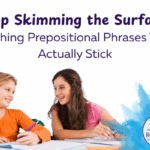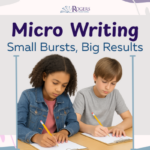For me, the weeks leading up to an in-service week are the most exciting and the most overwhelming. I am eager to meet my students and make my classroom come alive, but I also know there’s a lot of “boring” work I should be creating as well. For a Workshop Model classroom, there is quite a bit of paperwork and organization that needs to happen before the students arrive. Here are some points to consider:
Turning in Work or Collecting Work
If you have spent any time looking into the workshop model, you already know that teachers are very passionate about their methods for collecting work. Some have strict guidelines for exactly how students will put papers in a folder or set up a binder, and what exactly goes in a notebook. I remember being so worried that I was using some of these items wrong when I first started that it almost sent me into panic attacks! I am letting you off that hook! The non-negotiable in a workshop model classroom is that the students are working and it is collected in an orderly way. Sometimes, the work will be collected or at least looked at by the teacher. That’s really it! How you do that is completely up to you. (cue panic attack due to choice fatigue…now!)
I will share a few ideas below, but it is important for you to know your own personality and what works for YOU. You HAVE to teach your method and be consistent. The worst thing you could do is be wishy-washy with your system and method, and not follow through. The students will learn and thrive in any system you set up as long as you teach, model, expect, repeat. Promise.
- 3-Ring Binders ~ Some teachers love the ease of keeping everything in one place and easily moving items around when needed. You can add sheet protectors to turn papers into dry erasable, reusable worksheets (which is great for peer editing forms and checklists) and to hold small books and items. They can have all their writing supplies in a pouch in the front and the binder can be divided into parts of a Writers’ Workshop (planning, drafting, editing, revising, publishing) or into reading genres or even skills. The options are truly limitless. Personally, I love all of those options for a 3-ring binder, but I found my kids were constantly breaking the rings to where they didn’t align properly, so that’s something to consider as well.
- Notebooks (spiral or composition) ~ Many workshop model trainings will encourage students designing their own writers’ notebook and own readers’ notebook. A lot of times “they” say these notebooks are to jot down students’ thinking, but then they debate on what exactly SHOULD go in the notebook. In my humble opinion, I believe this is up to you. Do students enjoy decorating their own journal and making it a personal reflection of themselves? SOME do (as with any activity). Will you harm students if you have something in the notebook that others say shouldn’t be there – NO. I think rather than debate what should and should not go in the notebook, the true debate is spiral notebooks or composition books. This one will get teachers heated! If you are unsure in your stance here, think about whether you want papers to be removed or not. In a spiral, students can easily remove paper, which can be good or bad. The stitching on a composition book makes this infinitely more difficult.
- Folders ~ You can easily use bradded or non-bradded folders to have students store their writing. You can have one folder for drafting and one for publishing. You can add reference pages that will help students such as sight words reference, editing checklists, etc. When I first taught workshop model, I used folders. I took two bradded folder per student and made an extended folder that helped walk students through the writing process (check out the tutorial here). Obviously, these can be used for Readers’ Workshop too. Folders can hold small books and documents to guide students during collaborative and independent work.
Collecting Work
In terms of collecting work, consider your level of organization, time management, and grading policy. No small feat – I know! Think about what you plan on grading and/or checking. In other words, I never graded my students reading reflections or brainstorming, but I definitely collected it now and then. It was a formative assessment for me and a way for me to give feedback outside of our conferencing time. So, when my students had notebooks for these items, I collected five per class every other week. It saved me from going home with 50 notebooks at once!
For graded items, I got to the point where I would grade while in a conference. I didn’t take away from the beauty of our conversations and learning opportunities, but if I had asked them to find 10 descriptive adjectives over the course of a week in their writing, I would have them highlight those prior to our conference and I could see quickly if they understood. It’s also possible to take a grade on that with no papers being collected! You can also bring rubrics to conferences and after your meeting, fill them out quickly (but methodically).
If you want turn-in trays or areas, think about where the trays are placed, what goes in there, how often, and what your turn-around time should be. I stopped using turn-in baskets when I realized students were just turning things in haphazardly and I had limited follow through on turn-around time. It didn’t gel with my personality, but others do great with this system!
Access to Supplies – Writing and Books (including book boxes)
- Writers’ Workshop ~ In a Writers’ Workshop, it’s really helpful to have a great flow to the classroom. Consider having an area for students to peer conference, a small group area, a technology/publishing area, a reference area with dictionaries, thesauruses, and writing hints, and definitely a place for students to get supplies. While students who continually show up without a pencil are super irritating, it’s not really helpful to have that student waste time during writing because of it. Don’t forget to include all types of scaffolded paper for students to access as well.
- Readers’ Workshop ~ Access to books is a must! I also want to illustrate some systematic issues that can arise. When I taught second grade, I created the cutest little reading area (it was pre-Pinterest, so it was even more miraculous)! I had four bookshelves that created a comfortable reading area. It was perfect…until students came into my classroom. Then, problems quickly arose. Students were reading in the adorable designated area, and other students were searching for books. Which meant they were standing on, climbing over, and generally annoying all the students who were reading. Too bad “Nailed It!” wasn’t a show then. For that year, I simply turned my bookshelves around, so students read inside while others perused books on the outside. It wasn’t perfect, but it worked. Since that year, I have designed two separate areas: one area should be quiet for reading, and the other should be conversational for students to look for books. I want students to talk and suggest books to classmates as they search because it builds excitement and enjoyment.
Flexible Grouping Areas (Guided Reading Area)
While we’ve already touched on this some above, it bears repeating! You need all kinds of areas for students! Students should have individual workspaces, spaces where they can meet with peers and work collaboratively, a teacher small group area, and places for students to acquire materials.
Similar to my mistake in the reading area, I made another mistake when I taught fifth grade in a rougher school. It was super difficult to keep the kids on task once we broke from whole group instruction. I had always had my “teacher table” or teacher group in one corner of the room. Why? Because that is where I have ALWAYS seen it in books, blogs, and classrooms. After a year of frustration with my students misbehaving during independent/small group work, I put my small-group area in the middle! Yup, smack dab in the middle of the classroom. I worked with students there, and they had more areas around the room to work and they were close enough to me that it cut down considerably on misbehavior!
Documentation Collection
To tech, or not to tech? I can’t answer that for you…go with what you prefer. However, you MUST document! Things you should document:
- Reading ~ what books students are reading, fluency, basic comprehension, use of strategies, your conference notes, and their personal goals.
- Writing ~ what students are writing about, what type of writing, where they are in the writing process, your conference notes, and their personal goals.
Since most of my classroom experience is pre-tech, I resort to a traditional binder. I have a reading binder and a writing binder. I have a tab for each student and behind that tab is a log that indicates what they are writing or reading, summative and formative assessments, samples of work, and my documentation notes. It works for me, but my teacher BFF of course techs it up and it is amazing!




